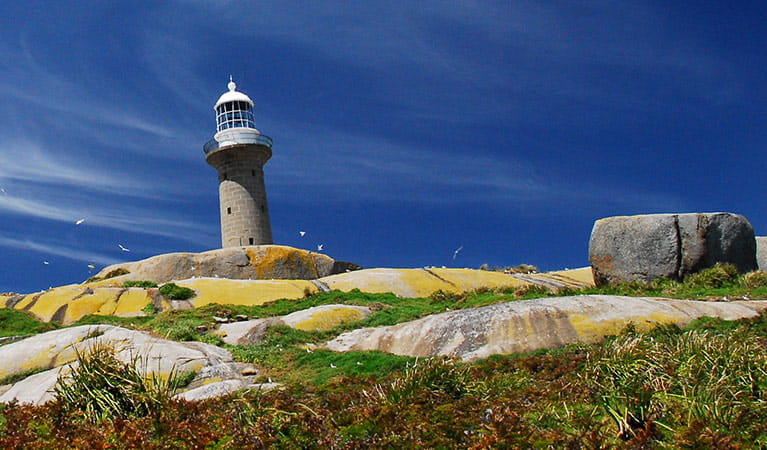Montague Island Lighthouse
Barunguba Montague Island Nature Reserve
Overview
Montague Island Lighthouse on Barunguba Montague Island is the perfect place to get in touch with history while seeing dramatic views, amazing birds and marine wildlife.
- Type
- Historic buildings/places
- Price
-
Guided tour fees apply
- What to
bring - Hat, sunscreen, drinking water
- Bookings
Book your tour with one of these operators: Charter Fish Narooma, Island Charters, Lighthouse Charters, Montague Island Game and Sport Fishing and Narooma Charters
- Please note
- A minimum age of 5 years applies for all visitors to Barunguba Montague Island
- Tours may be subject to late cancellation in the event of unfavourable weather and sea conditions
- You can choose a longer morning tour (2.5hrs on the island) or a shorter afternoon tour (1hr on the island).
- The island can be windy. A windproof jacket is a good idea at all times.
Let your inner history buff loose and explore Montague Island Lighthouse. The lighthouse, built way back in 1881, is impossible to miss – it’s an impressive granite structure that will have you reaching for your camera. Climb the winding staircase to the top – it’s a great vantage point for whale watching and the amazing 360 degree views will take your breath away.
Retaining most of its original form and features, little has changed from the time the lighthouse was constructed to what you will see today. Designed in 1873 and completed almost a decade later, it’s a testament to Victorian design and innovation. Taking a guided tour is a great way to learn more about the unique heritage of the lighthouse and surrounding wildlife.
Stay overnight at either Montague Island Head Lighthouse Keeper's Cottage or Montague Island Assistant Lighthouse Keeper’s Cottage. In the morning light explore the island along the Barunguba Montague Island walking track.
Take a virtual tour of Montague Island lighthouse captured with Google Street View Trekker.
Map
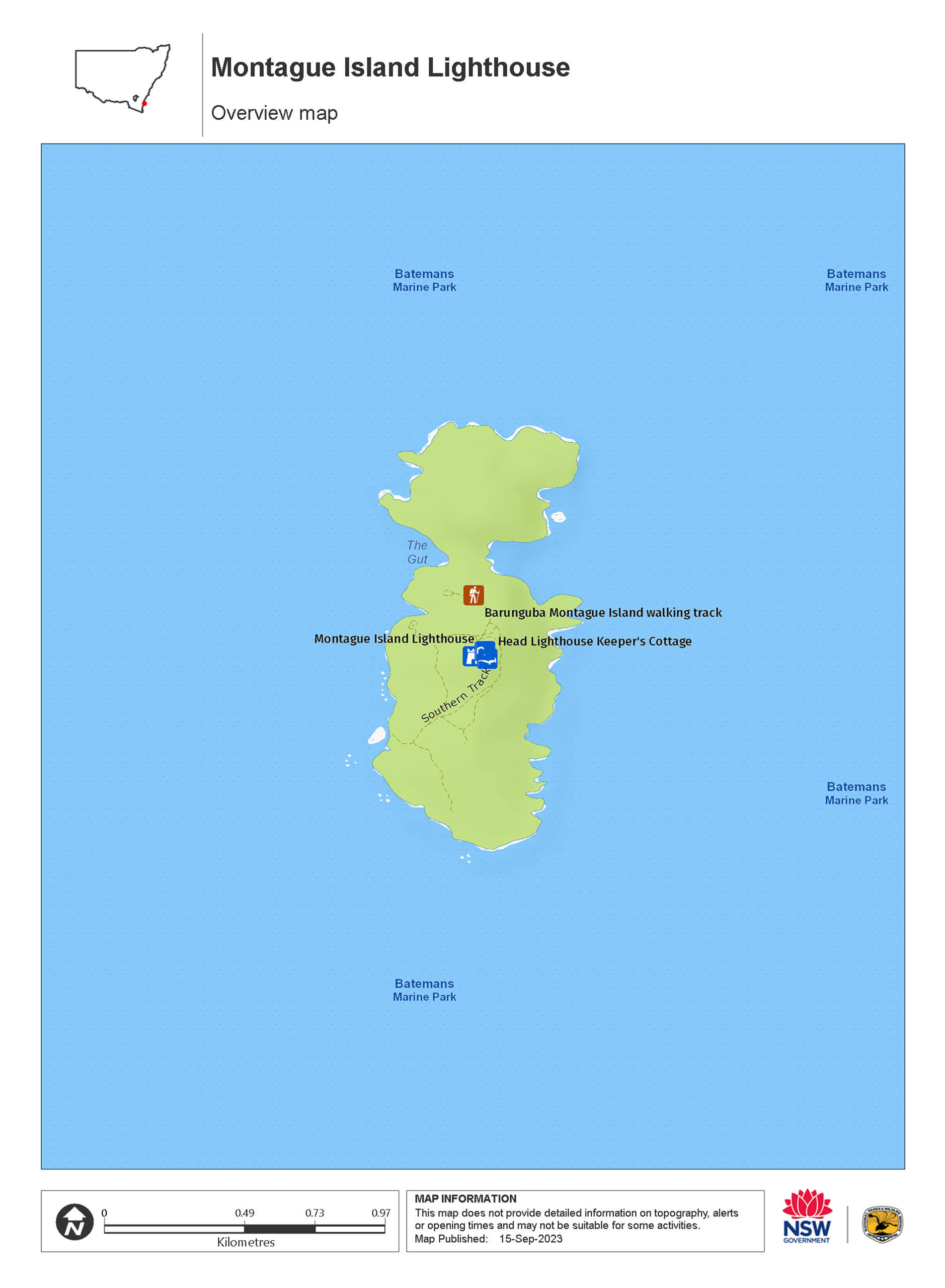
Map legend

Local alerts
For the latest updates on fires, closures and other alerts in this area, see https://www.nationalparks.nsw.gov.au/things-to-do/historic-buildings-places/montague-island-lighthouse/local-alerts
General enquiries
- National Parks Contact Centre
- 7am to 7pm daily
- 1300 072 757 (13000 PARKS) for the cost of a local call within Australia excluding mobiles
- parks.info@environment.nsw.gov.au
Park info
- Narooma, NSW, 2546
- in Barunguba Montague Island Nature Reserve in the South Coast region
Barunguba Montague Island Nature Reserve is always open but may have to close at times due to poor weather or fire danger.
Please note: A minimum age of 5 years applies for all visitors. Barunguba Montague Island is only accessible via one of NSW National Parks and Wildlife contracted commercial vessel tour operators. Go to www.eurobodalla.com.au for details.
Visitor info
All the practical information you need to know about Montague Island Lighthouse.
Getting there and parking
Get driving directions
Montague Island Lighthouse is in Montague Island Nature Reserve. Montague Island is only accessible via one of NSW National Parks & Wildlife contracted commercial vessel tour operators.
Montague Island water transport charters include:
- Charter Fish Narooma
- Island Charters
- Lighthouse Charters
- Montague Island Game and Sport Fishing
- Narooma Charters & Montague Island Tours
Montague Island tours and overnight stays depart from:
- Narooma wharf - Bluewater Drive, Narooma
- Bermagui wharf - Bermagui Harbour, Bermagui
A minimum age of 5 years applies for all visitors to Montague Island. Visitors need to be able to climb the island’s jetty ladder and the steep hill that follows.
Road quality
- Sealed roads
Vehicle access
- 2WD vehicles
Weather restrictions
- All weather
Parking
Parking is available at Narooma and Bermagui wharves.
Best times to visit
There are lots of great things waiting for you on Montague Island Nature Reserve. Here are some of the highlights.
Spring
New Zealand and Australian fur seals are at their peak on the island during spring, making this the perfect time for some seal-spotting. To tempt you even more, humpback whales can often be spotted along the coastline, and pods of dolphins come to play among the boats too – book a guided tour that includes whale watching for the best chance to spot this special sea mammal in its own environment From October huge numbers of shearwaters begin to arrive and nest on the island through the summer.
Summer
Soak up the summer sun on a guided tour of Montague Island and provides some of the best weather for photographs.
Winter
From late winter the seal colony on the island starts to grow. It can get quite chilly in winter so pack warm clothes.
Weather, temperature and rainfall
Summer temperature
Average
15°C and 25°C
Highest recorded
38.7°C
Winter temperature
Average
4°C and 16°C
Lowest recorded
2.1°C
Rainfall
Wettest month
March
Driest month
July
The area’s highest recorded rainfall in one day
182mm
Maps and downloads
Prohibited
Pets
Pets and domestic animals (other than certified assistance animals) are not permitted. Find out which regional parks allow dog walking and see the pets in parks policy for more information.
Smoking
NSW national parks are no smoking areas.
Learn more
Montague Island Lighthouse is in Barunguba Montague Island Nature Reserve. Here are just some of the reasons why this park is special:
A sacred place
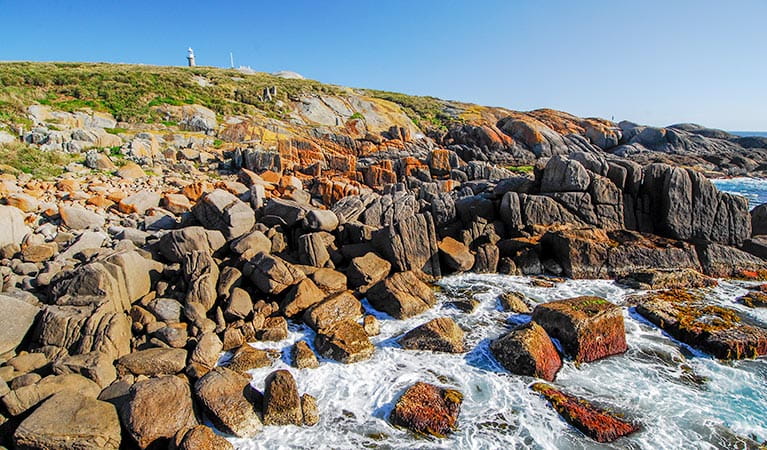
The Yuin people have had a long connection with Barunguba Montague Island, travelling to the island for traditional ceremonies and food, and using it as a men's teaching place. It would have been a dangerous trip - 9km each way by bark canoe. There are many Aboriginal artefacts and middens on the island. Barunguba is the eldest son of Gulaga (Mount Dromedary) and a brother to Najunuka (Little Dromedary). The older brother, Barunguba was allowed out to sea while Najunuka, the younger brother, had to stay close to his mother. To recognise its cultural significance to Yuin people, Barunguba was declared an Aboriginal Place under the National Parks and Wildlife Act 1974 in June 2018.
Colonial heritage
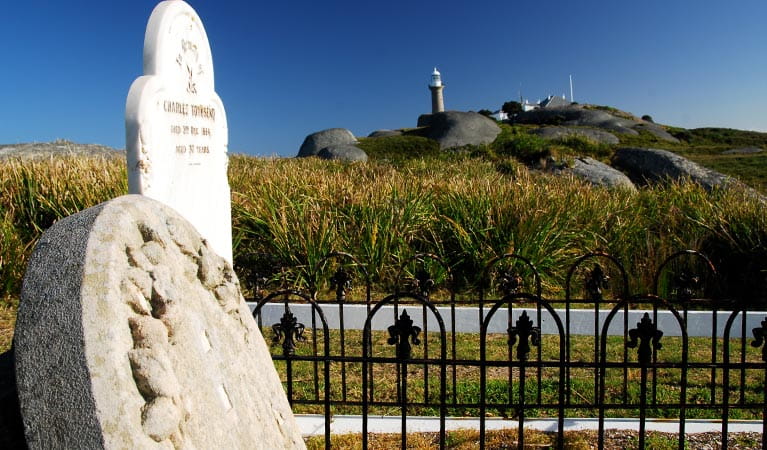
Get in touch with Australia's colonial history - Captain James Cook spotted the island from his tall ship in 1770 but assumed it was part of the mainland. It wasn't until 1790 that the island was officially identified by European Settlers as an island, and named 'Montagu' after the Earl of Halifax George Montagu Dunk, by the master of the convict ship Surprise. The island received visits from several shipwrecked sailors, and during the goldrush seabird eggs were collected from the island to sell to miners.
- Montague Island Lighthouse Montague Island Lighthouse on Barunguba Montague Island is the perfect place to get in touch with history while seeing dramatic views, amazing birds and marine wildlife.
A sanctuary for seabirds, seals and whales
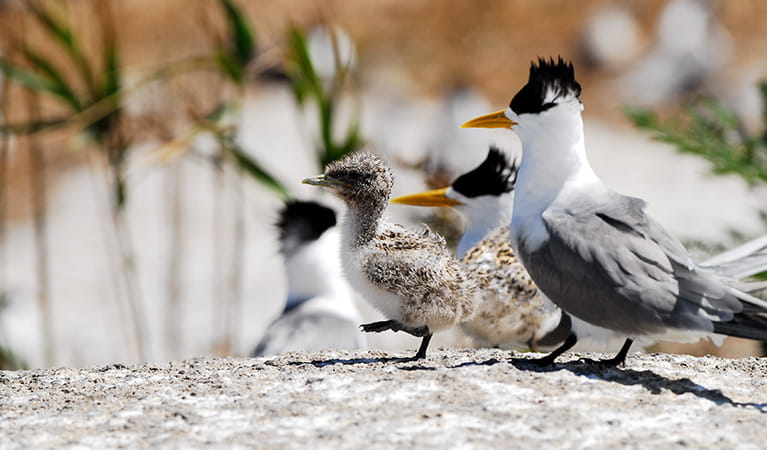
The protected waters of Barunguba Montague Island are a playground for hundreds of seals who make the island their home, all year round. Between September and November you can also see humpback and southern right whales pass the island on their annual migration south. Watch for blowholes and spectacular displays from the island or on a combined whale watching and island tour. With more than 90 bird species seen on the island, and 15 species breeding there, you’ll be reaching for your binoculars – and camera – at every turn. Up to 8,000 penguins live on the island at any one time. Between September and March they are joined by three species of shearwaters, which can produce more than 12,000 chicks per year, and their colonies seem to be growing!
- Barunguba Montague Island walking track This 1.5 km coastal walk around Barunguba Montague Island is short but challenging. It takes you past the historic lighthouse and precious penguin breeding boxes.
- Montague Island Lighthouse Montague Island Lighthouse on Barunguba Montague Island is the perfect place to get in touch with history while seeing dramatic views, amazing birds and marine wildlife.
Plants and animals protected in this park
Animals
-
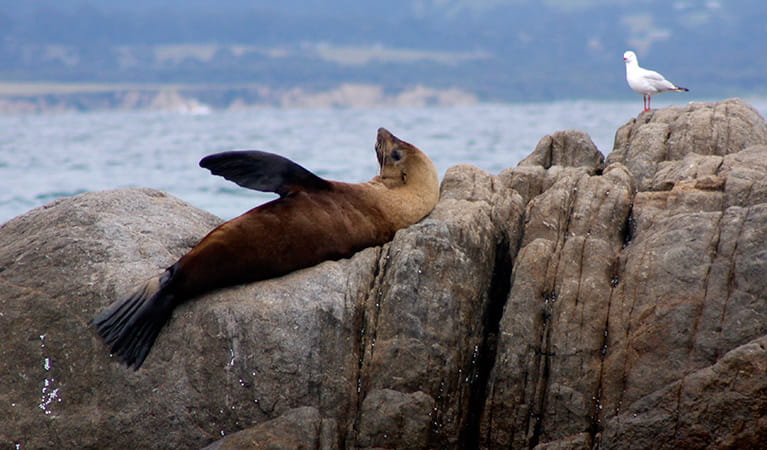
Australian fur seal (Arctocephalus pusillus doriferus)
The largest fur seal, Australian fur seals are found in isolated rocky outcrops and islands along the NSW coast. They come ashore to form breeding colonies and can often be seen at Barunguba Montague Island Nature Reserve.
-
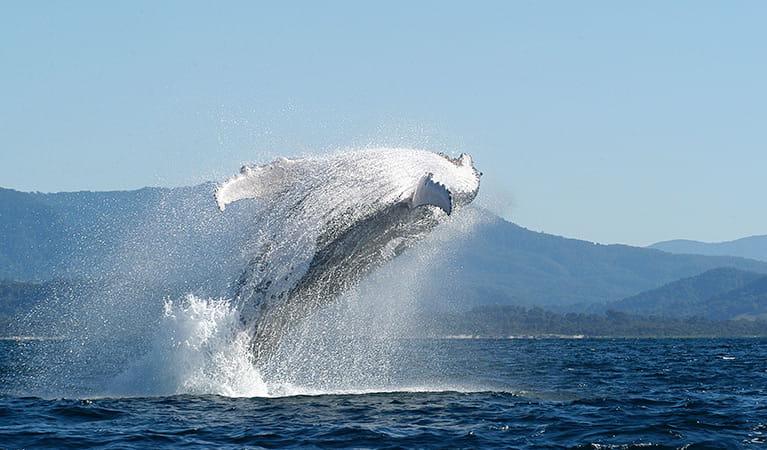
Humpback whale (Megaptera novaeangliae)
The humpback whale has the longest migratory path of any mammal, travelling over 5000km from its summer feeding grounds in Antarctica to its breeding grounds in the subtropics. Its playful antics, such as body-rolling, breaching and pectoral slapping, are a spectacular sight for whale watchers in NSW national parks.
-

White-bellied sea eagle (Haliaeetus leucogaster)
White-bellied sea eagles can be easily identified by their white tail and dark grey wings. These raptors are often spotted cruising the coastal breezes throughout Australia, and make for some scenic bird watching. Powerful Australian birds of prey, they are known to mate for life, and return each year to the same nest to breed.

